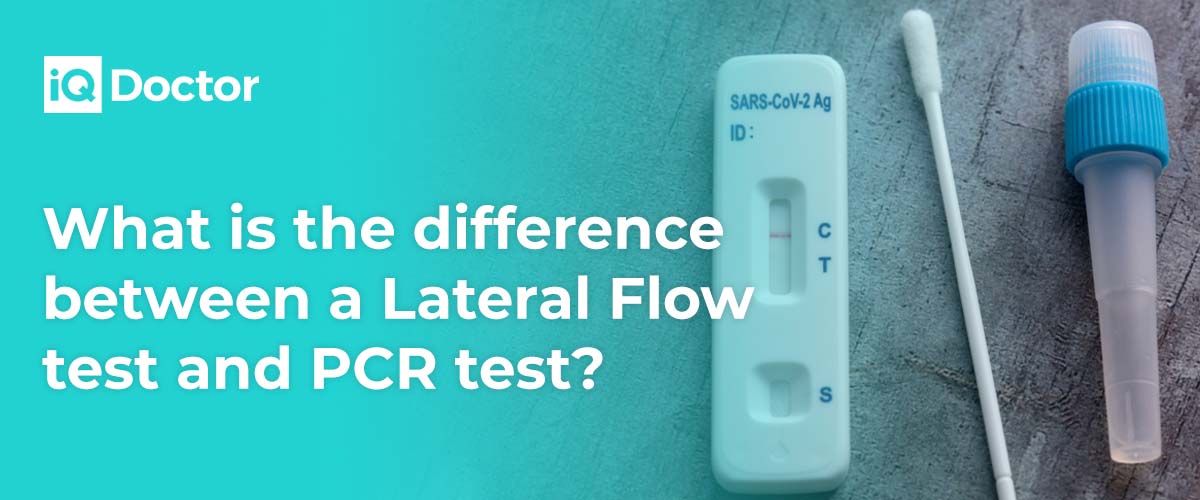What Is the Difference Between a Lateral Flow Test and a PCR Test?
07 October, 2021 | Jane Thomas - Marketing

The Lateral Flow Test and the PCR test are the two tests that are being widely used in the UK at the present time. These tests have supplemented the vaccination efforts by limiting the spread of the virus and keeping Britons safe.
As travel restrictions to the UK get updated, certain COVID-19 tests are becoming more relevant than others. The new testing rules will take effect on October 4th, 2021. Under the new rules, fully vaccinated travellers from non-red listed countries are exempt from taking a PCR test before departure. However, they will have to take a Day 2 PCR test on arrival, but this will last until the end of October and be replaced with a cheaper Lateral Flow Test.
Unvaccinated travellers, or those coming from a red-listed country, will still be required to take multiple PCR tests and self-isolate for ten days.
The PCR and Lateral Flow Test can either be acquired through the NHS or purchased through government-accredited providers, such as IQ doctor.
If you are wondering what the difference between the two tests is, read on to find more.
Overview of Lateral Flow Test and PCR test
Lateral Flow Test
Rapid antigen testing (Lateral Flow Testing) means that the test results can be obtained "on the spot" within half an hour of taking a swab sample. Everyone in the UK now has access to Lateral Flow Testing. For individuals without COVID-19 symptoms, these tests may be used to demonstrate their COVID-free status.
Lateral Flow Tests are also great for testing a large portion of the population without spending much time or money. In the UK, about one in three people who have contracted COVID-19 are asymptomatic. However, patients without symptoms are still capable of spreading the infection to other people. The Lateral Flow Test effectively detects infected patients with the virus and risks applying it to other people.
PCR test
For more than a year now, PCR (polymerase chain reaction) tests have been used to test the population of the UK. It is a complete 'swab' test, and people can either take their swab sample in a drive-through centre or at home using home test kits. The swab sample is then sent to a lab, where experts use highly specialised equipment to look for coronaviruses genetic material. Results are then sent through text or phone call in up to five business days, although they are usually faster.
What are the differences between Lateral Flow Testing and PCR testing?
The main differences between the two tests are:
Lateral Flow Tests are used to look for proteins (antigens) in the swab sample to detect the presence of COVID-19. On the other hand, PCR (polymerase chain reaction) tests are designed to look for genetic material (known as RNA), which is the material that instructs the virus to produce these proteins.
Lateral Flow Tests are relatively inexpensive, whereas PCR tests can cost many times more.
While the Lateral Flow Test results are generally accurate, they need to be confirmed using a PCR test in case of a positive result. PCR test results are more accurate and reliable and do not need another confirmatory test.
Lateral Flow Testing is intended to be used by people who do not have any symptoms of COVID-19, whereas PCR testing is intended for people who are exhibiting symptoms.
The Lateral Flow Test results are ready within 30 minutes of taking the test, whereas the results of a PCR test can take between 2 to 4 days.
The Lateral Flow Test works by combining the swab sample with a solution that produces certain kinds of viral proteins. The mixture is then applied to a testing strip, which contains an antibody that is designed to bind to COVID-19 proteins if they are present. It shows a positive or negative result through a mark that appears on the upper or lower part of the strip. This process does not require a laboratory and can be done at home within thirty minutes. In contrast, the swab sample for the PCR test has to be sent to a laboratory where it is heated and cooled using certain reagents that work to change the RNA of COVID-19 into DNA. This DNA is then reproduced to make millions of copies, which allows the technicians at the laboratory to identify whether COVID-19 is present or not. This process takes several hours and requires complex lab equipment, and needs expert technicians to perform the entire procedure.
In the end, deciding which test to take depends upon a number of factors. In some cases, you might be mandated to take a specific test (either PCR or Lateral Flow Test) and have no other choice. However, in some cases, it might be up to you. For instance, if you are travelling to certain destinations (like the US, Germany, France etc.), or need to frequently demonstrate that you are COVID-free (such as your workplace), a Lateral Flow Test is the best option. But, if you have COVID-19 symptoms, a PCR test is what you will need.
Reviewed By

Omar El-Gohary
The superintendent and lead pharmacist - registration number 2059792.
Omar is passionate about developing healthcare technology to empower our patients.
Related Posts
Tags
No Tags Available


